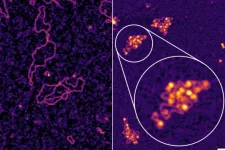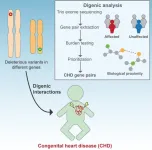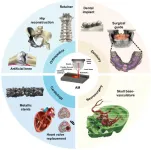(Press-News.org) In their effort to answer a decades-old biological question about how the hepatitis B virus (HBV) is able to establish infection of liver cells, research led by Memorial Sloan Kettering Cancer Center (MSK), Weill Cornell Medicine, and The Rockefeller University identified a vulnerability that opens the door to new treatments.
The team successfully disrupted the virus’s ability to infect human liver cells in the laboratory using a compound already in clinical trials against cancer — laying the groundwork for animal model studies and potential drug development based on their insights, according to findings published February 20 in Cell, a top life sciences journal.
Hepatitis B is a liver infection that affects almost 5% of the world’s population. It causes long-term damage to liver cells and is one of the leading causes of liver cancer. More than 250 million people worldwide have chronic HBV infections and the virus causes more than 1 million deaths a year, making it the second most deadly infection worldwide, according to the World Health Organization.
The research was led by chemical biologist Yael David, PhD, at MSK, working together with hepatologist and virologist Robert Schwartz, MD, PhD, at Weill Cornell Medicine and Viviana Risca, PhD, at The Rockefeller University.
“This project started from our fundamental interest in how the virus’s chromosomes might look and function and led to unexpected discoveries of how the viral infection is established in human cells,” Dr. David says.
Study first author Nicholas Prescott, PhD, pursued the research in the David Lab as his graduate thesis. “This is a great example of how investment in ‘basic science’ and investigation of fundamental biological questions can open the door to medical advances,” he says. “I always thought I’d be working on questions that decades later someone might cite in a paper when they come up with a cure for some disease. Never in a million years did I expect to lead a project that identified such a strong candidate for drug development for a global scourge like hepatitis B.”
A Biological Paradox Sparks a Collaboration
The research began with a chance meeting and a longstanding paradox.
Dr. Schwartz, an associate professor of medicine in the Division of Gastroenterology and Hepatology at Weill Cornell Medicine, was introduced to Dr. David about six years ago at a retreat for Weill Cornell Physiology, Biophysics and Systems Biology graduate school faculty, where they both hold appointments.
“On the surface, our research programs seem to have no overlap,” Dr. David says. “He studies hepatitis B, while my lab focuses on understanding how gene expression is regulated through a process called epigenetics. However, I was fascinated to discover that viruses like hepatitis B hijack epigenetic mechanisms, even using human DNA-packaging proteins to regulate their activity.”
Not long after, Dr. Prescott, then a doctoral student in the Tri-Institutional PhD Program in Chemical Biology, was preparing for a stint in the David Lab at MSK’s Sloan Kettering Institute. “His interest in epigenetic regulation in pathogens immediately made me consider HBV an ideal model system for him to explore,” Dr. David says.
At the heart of the mystery that intrigued the researchers lies a key viral gene that encodes for a protein called X. This protein is essential for HBV to establish a productive infection in host cells and the expression of its viral genes. However, the X gene itself is encoded within the viral genome.
“This raises a classic chicken-and-egg question that has puzzled scientists for decades,” Dr. David says. “How does the virus produce enough X protein to drive viral gene expression and establish infection?”
Furthermore, the gene that encodes protein X is considered the virus’s oncogene — that is, the gene responsible for the disease’s progression toward cancer, Dr. Prescott adds. That’s because protein X degrades proteins in the host that are involved with DNA repair. Not only does this keep the host from silencing protein X’s activity, but the infected cells are also more likely to accumulate DNA errors that build up over the years and decades, leading to the development of cancer.
Challenges With Existing Treatments for Hepatitis B
“One of the main challenges with treating hepatitis B is that the existing treatments can stop the virus from making new copies of itself, but they don’t fully clear the virus from infected cells, allowing the virus to persist in the liver and maintain chronic infection,” says Dr. Schwartz, whose lab contributed biological and clinical expertise in the virus, as well as the human liver cell models used in the study.
The hepatitis B vaccine is also effective, but maintaining immunity often requires booster shots. Moreover, it doesn’t help people who are already infected. This happens, for example, due to transmission of the virus from mother to child, which is very common in developing countries. Access to vaccines and treatment is also more limited in some parts of Africa and Asia, where rates of infection are higher.
Building a New Platform to Study Hepatitis B
Digging into the mystery of protein X was a challenge, explains Dr. Prescott, who is now a postdoctoral fellow in the Laboratory of Chromosome and Cell Biology at The Rockefeller University. The existing tools weren’t capable of shedding light on what was happening in those critical early hours of an infection.
This is where the David Lab’s expertise in how DNA gets packaged, read, and modified proved essential. They successfully generated the HBV minichromosome for the first time, using their capabilities in reconstituting viral DNA in complex with human histones — which are proteins that package and organize DNA.
“This platform became a powerful tool not only to study the virus’s biochemistry but also to analyze, in detail, what happens in the critical first hours of an infection,” Dr. David says.
For Protein X, Packaging Makes All the Difference
The research team determined that in order for protein X to get made, the hepatitis B virus’s DNA needs to get organized into DNA-histone complexes called “nucleosomes.” Nucleosomes are like beads on a string — the string is the viral DNA, and the beads are host-provided histone proteins, around which DNA gets wrapped; nucleosomes are the building blocks of chromatin, the material that makes up chromosomes.
It was this part of the project that tapped into the expertise of Dr. Risca from Rockefeller University. The Risca Lab studies the 3D architecture of the genome and how the packaging of DNA helps to control the transcription of genes. They had the tools and expertise to ensure that what the scientists were seeing in the new platform for studying the virus matched the reality of a human infection.
“Conventional wisdom says that packaging a gene’s DNA into nucleosomes would block or slow down the cell’s ability to read out that gene to make functional proteins, like protein X,” Dr. Risca says. “But in complex organisms like humans and in the viruses that infect us, gene regulation is not always so straightforward. The presence and the positioning of nucleosomes on DNA can be important in directing cellular mechanisms to transcribe some genes. We found that to be the case for the HBV gene encoding protein X — the presence of nucleosomes on the viral genome is necessary for the transcription of RNA that gives rise to functional protein X.”
Identifying a Promising Drug Candidate Against HBV
This discovery opens the door to understanding how the X gene is regulated and how HBV infection is established. Moreover, the researchers were elated to discover a potential therapeutic opportunity: If one could disrupt the formation of these chromatin structures, then one could disrupt the virus’s ability to start and maintain an infection.
The team tested five small-molecule compounds known to impair chromatin formation. Only one blocked the production of protein X in liver cells: an anticancer drug candidate called CBL137.
Importantly, it worked at very low concentrations — many times smaller than participants in clinical trials for cancer were receiving, and using doses that only affected the virus, but not human cells.
“This made us very optimistic about the possibility of developing a treatment approach while preventing or limiting side effects,” Dr. David says.
“Moreover, if these results are confirmed through additional study, we are optimistic the approach could be used to treat chronic infections for the first time — and therefore could represent a potential cure,” Dr. Schwartz adds.
Additionally, CBL137 might prove similarly useful to target or study other chromatinized DNA viruses like herpesviruses and papillomaviruses, the researchers note.
Next Steps for the Research
To further develop the team’s research toward a potential clinical trial, the next step would be to study the safety and effectiveness of CBL137 in animal models — though these are limited due to the narrow range of species HBV can infect, the researchers say.
All of the researchers stressed that the study wouldn’t have been possible without the close collaboration between the three institutions, which brought together the necessary expertise and technological resources — from MSK’s atomic force microscope to the Genomics Resource Center and High-Performance Computing Cluster at Rockefeller University.
“I think this is a sterling example of what makes the Tri-I such a great place to do science,” says Dr. Prescott, whose research has been supported by a prestigious F99/K00 grant from the National Cancer Institute, which funds promising researchers through graduate studies and postdoctoral training, helping them to establish independent careers. “Without the contributions from all the labs, this research would not have been possible. When it came time to find a place to do my postdoc, I was like, ‘Why would I ever leave?’ ”
Additional Authors, Funding, and Disclosures
Additional authors include Tracy Biaco of MSK and Weill Cornell Medicine; Andrés Mansisidor (currently at the Stevens Institute of Technology), and Justin Rendleman of The Rockefeller University; Yaron Bram, Christine Lim, and Rachel Tiersky of Weill Cornell Medicine; Sarah Faulkner, Eralda Salataj, Pierre-Jacques Hamard, and Richard Koche of MSK; Abigail Lemmon of MSK and the Tri-Institutional PhD Program in Chemical Biology; and Liliana Garcia-Martinez, Rodrigo Borges, and Lluis Morey of the Sylvester Comprehensive Cancer Center and University of Miami Miller School of Medicine.
The research was supported by the National Cancer Institute (P30CA08748), the National Institutes of Health (T32GM115327-Tan, F99CA264420, F32GM140551, T32GM136640-Tan, DP2GM150021, R01AA027327, R01AI107301, R01DK121072), the National Science Foundation (2017239554), the Josie Robertson Foundation, the Alfred Sloan Research Foundation, the MSK Center for Epigenetics Research, the Rita Allen Foundation, the Irma T. Hirschl Trust, the Starr Cancer Consortium (I16-0058), the V Foundation for Cancer Research, the Stavros Niarchos Foundation (SNF) as part of its grant to the SNF Institute for Global Infectious Disease Research at The Rockefeller University, the American Cancer Society (PF-23-1034949-01-CCB), the U.S. Department of Defense (W81XWH-21-1-0978), and the Paul G. Allen Family Foundation (UWSC13448).
Unrelated to this work, Dr. Schwartz reports service on the scientific advisory boards of Miromatrix and Lime Therapeutics, and he is a speaker and consultant for Alnylam.
Read the study: “A nucleosome switch primes Hepatitis B Virus infection,” Cell. DOI: 10.1016/j.cell.2025.01.033
END
Digging into a decades-old hepatitis B mystery suggests a new potential treatment
2025-02-20
ELSE PRESS RELEASES FROM THIS DATE:
Big birds like emus are technical innovators, according to University of Bristol researchers
2025-02-20
Large birds – our closest relations to dinosaurs - are capable of technical innovation, by solving a physical task to gain access to food.
This is the first time scientists have been able to show that palaeognath birds such as emus and rheas can solve tricky problems.
In the study, published today in Scientific Reports, emus, which have previously been called the ‘world’s dumbest bird’ were able to create one new technique to access food (lining up a hole with a food chamber) and moved the hole in the most efficient direction towards food in 90% of cases. A male rhea ...
Hidden genetic causes of congenital heart disease identified
2025-02-20
New York, NY [February 20, 2025]—Scientists at the Icahn School of Medicine at Mount Sinai and collaborators have identified novel genetic interactions that may contribute to congenital heart disease (CHD), a common birth defect. Details on their findings were reported in the February 20 online issue of The American Journal of Human Genetics [DOI: 10.1016/j.ajhg.2025.01.024].
“Our research reveals the potential for digenic inheritance—where two genes work together to cause disease—expanding our understanding of the genetic underpinnings of congenital heart ...
Semaglutide and nonarteritic anterior ischemic optic neuropathy
2025-02-20
About The Study: The results of this study suggest a modest increase in the risk of nonarteritic anterior ischemic optic neuropathy among individuals with type 2 diabetes associated with semaglutide use, smaller than that previously reported, and warranting further investigation into the clinical implications of this association.
Corresponding Author: To contact the corresponding author, Cindy X. Cai, MD, MS, email ccai6@jhmi.edu.
To access the embargoed study: Visit our For The Media website at this link https://media.jamanetwork.com/
(doi:10.1001/jamaophthalmol.2024.6555)
Editor’s ...
Inequities in the application of behavioral flags for hospitalized pediatric patients
2025-02-20
About The Study: This cohort study found significant inequities in incidence of behavioral flags in the electronic health record among racially and socioeconomically marginalized pediatric patients. This finding was most pronounced for Black or African American patients younger than 8 years, suggesting that this phenomenon may be a response to Black families rather than specific patient behavior.
Corresponding Author: To contact the corresponding author, April Edwell, MD, MAEd, email April.edwell@ucsf.edu.
To access the embargoed study: Visit our For The Media website at this link https://media.jamanetwork.com/
(doi:10.1001/jamanetworkopen.2024.61079)
Editor’s ...
Paxlovid’s impact on hospitalization and death in COVID-vaccinated older adults far weaker than previously thought
2025-02-20
Paxlovid does not significantly reduce COVID-19 hospitalization and mortality among vaccinated older adults, according to new UCLA-led research.
The study questions the assumption that Paxlovid’s effectiveness in reducing COVID-19 hospitalizations and deaths in unvaccinated adults also applies to vaccinated adults. Pfizer’s 2022 clinical trial found reduced COVID-19 hospitalization in unvaccinated middle-aged adults; while a subsequent 2024 clinical trial found no significant reduction in vaccinated middle-aged adults. Since most older Americans have already received two or more COVID-19 vaccines, Paxlovid’s effectiveness on vaccinated ...
Additive manufacturing of biomedical metals for medical implant fabrication
2025-02-20
Biomedical metal implant materials are widely used in clinical applications, including dental implants, hip replacement, bone plates, and screws. However, traditional manufacturing processes face limitations in meeting customized medical needs, internal structural control, and efficient material utilization. For example, when producing complex-shaped titanium alloy parts using conventional methods, the material consumption ratio is as high as 10:1-20:1, leading to significant material waste.
As a result, ...
Antioxidant-enzyme Interaction in non-communicable diseases
2025-02-20
Introduction
Oxidative stress, caused by an imbalance between reactive oxygen species (ROS) and antioxidant defenses, plays a central role in the development of non-communicable diseases (NCDs). These diseases, including cardiovascular disorders, diabetes, neurodegenerative conditions, cancer, and liver and kidney diseases, are among the leading causes of morbidity and mortality worldwide. Enzymatic and non-enzymatic antioxidants serve as the body’s primary defense against ROS, maintaining redox homeostasis and preventing cellular damage. However, when ROS levels exceed the capacity of antioxidant defenses, oxidative stress ensues, contributing ...
Turtles change nesting patterns in response to climate change
2025-02-20
New research shows that turtles are responding to climate change by nesting earlier.
Researchers monitoring nesting green and loggerhead turtles in Cyprus have discovered they are returning to their regular nesting spots earlier each year to compensate for rising temperatures.
In sea turtles, temperature determines the biological sex of offspring, with more females born when it is warmer, as well as fewer successful hatchings when it gets too hot.
Turtles also have “natal philopatry”, which means they return to nest in the area where they themselves hatched.
A research team from the University of Exeter and the Society for the Protection of ...
New research links grape consumption to improved muscle health in both men and women
2025-02-20
A new study from Western New England University (WNE) has revealed that long-term grape consumption significantly impacts muscle health, with notable benefits for both men and women. The research, published in the journal Foods, suggests that a diet including grapes can modify gene expression in muscle, potentially offering a new nutritional strategy for maintaining muscle mass and function.
Around 30 million tons of grapes are consumed every year, and their benefits extend beyond nutrition. Grapes have been shown to ...
Both sides of the coin: Lack of consensus on continuing vs. discontinuing opioid medications prescriptions for adults with chronic pain
2025-02-20
INDIANAPOLIS – Chronic pain is complex and difficult to treat. Prescribing opioid pain medications has become controversial but may help some patients.
With the goal of informing clinician practice, a new study explores the harms and benefits of continuing and of discontinuing the long-term prescription of opioid medicines to adults with chronic pain. The authors analyzed the opinions of 28 experts on the harms versus benefits of maintaining, tapering or terminating opioid pain medication prescriptions ...






